This site uses affiliate links, meaning that if you make a purchase through our links, we may earn an affiliate commission.
Visiting Hiroshima Peace Memorial Park is an unforgettable experience. It will resonate within you, leave you speechless, and make you cry. It is one of the most powerful experiences that I ever had while traveling.
Here is a fascinating Hiroshima Peace Memorial Park self-guided walking tour.
However, if you feel like joining a guided tour, my recommendation is to attend Hiroshima Peace Memorial Park Walk Tour. You will have a local guide by your side who will give you an in-depth insight into the history of Hiroshima.
Another tour that I enjoyed was Hiroshima Cycling Peace Tour with a Local Guide. This tour is about 2 hours long and you will bicycle around Hiroshima Peace Memorial Park and see the Atomic Bomb Dome, the Cenotaph, Children’s Peace Monument, and the Peace Bell. It is a small group tour limited to no more than 10 people.
However, now, with no further delay, follow my Hiroshima Peace Memorial Park self-guided walking tour and learn about the history of the atomic bombing of Hiroshima, the location and significance of Hiroshima’s memorials and monuments, and unforgettable exhibits at Hiroshima Peace Museum.
Before we dive into a step-by-step Hiroshima Peace Memorial Park self-guided walking tour, here is Hiroshima At-A-Glance Guide which covers how to get to Hiroshima, how to get around, and where to stay in Hiroshima. I know it will help you plan your visit.
Hiroshima At-A-Glance Guide
Here are a few highlights about Hiroshima to help you plan your visit:
- Buy JR Pass
Before you even start planning your visit to Hiroshima, make sure to buy JR Pass. I am highly recommending it! You should get it before traveling to Japan. It will save you a lot of money! You can buy it here.
- How to Get to Hiroshima from Kyoto, or Osaka
If you have JR Pass and you are traveling from Kyoto or Osaka, then take the Shinkansen Hikari from Kyoto to Shin Osaka in Osaka. From Osaka at Shin Osaka, switch to Shinkansen Sakura for Hiroshima. The trip takes around 1 hour and 50 minutes from Kyoto and 1 hour and 30 minutes from Osaka.
Mizuho and Nozomi trains take 1 hour 25 minutes however, these trains are not covered by the pass.
- How to Get Around in Hiroshima
My recommendation is to buy Visit Hiroshima Tourist Pass. It is a great tool that will help you save money on transportation while you are visiting Hiroshima and the surrounding areas.
Another option is to use Hiroshima Sightseeing Loop Bus (Meipuru-pu). It is basically a hop-on hop-off circulation bus that goes around all the major sightseeing spots within Hiroshima city.
- Where to Stay in Hiroshima
Downtown Hiroshima is where you want to stay while you are exploring Hiroshima and the surrounding areas.
Downtown is right in the center of Hiroshima. Specifically, it is in-between Hiroshima Station and the Peace Memorial Park. You will be within a walking distance of some of the major tourist attractions, plus there are plenty of places to get a bite to eat and do some shopping as well.
Here are a few hotels that I am recommending that you check out:
Hotel Granvia Hiroshima is one of my favorite hotels that I always book if I am visiting Hiroshima. I like how close it is located to Hiroshima Station. In addition, all around the hotel, there is no shortage of shops, restaurants, and all kinds of small eating places, if you just need to grab a quick bite.
RIHGA Royal Hotel Hiroshima is another good choice for staying while you are visiting Hiroshima. It is perfectly located next to most of Hiroshima’s attractions. In addition, it is connected to a massive mall complete with countless food and shopping options.
Hiroshima Washington Hotel is another hotel that has a great location. It is just a short walk from Hiroshima Peace Memorial Park. In addition, there are many options for shopping and eating right next to the hotel.
- 1. Hiroshima At-A-Glance Guide
- 2. Events Leading to Atomic Bomb Explosion
- 3. Atomic Bombing of Hiroshima
- 4. Hiroshima Bombing Aftermath
- 5. Nagasaki Bombing
- 6. Hiroshima Today
- 7. Map of Hiroshima Peace Memorial Park Self-Guided Walking Tour
- 8. Hiroshima Peace Memorial Park Self-Guided Walking Tour
- 8.1. Atomic Bomb Dome
- 8.2. Hypocenter of Hiroshima Atomic Bomb
- 8.3. Children's Peace Monument
- 8.4. The Flame of Peace Sculpture
- 8.5. Cenotaph for the A-Bomb Victims
- 8.6. Hiroshima Peace Memorial Museum
- 8.7. Hiroshima National Peace Memorial Hall for the Atomic Bomb Victims
- 8.8. Aogiri Trees Exposed to the Bombing
- 9. Intrepid Scout's Final Thoughts About Hiroshima Peace Memorial Park
Events Leading to Atomic Bomb Explosion
In July 1945 the U.S. successfully tested a working atomic bomb.
Robert Oppenheimer (1904-1967), an American theoretical physicist and a director of the Los Alamos Laboratory of the Manhattan Project, chose to name the atomic bomb test as “Trinity” test.
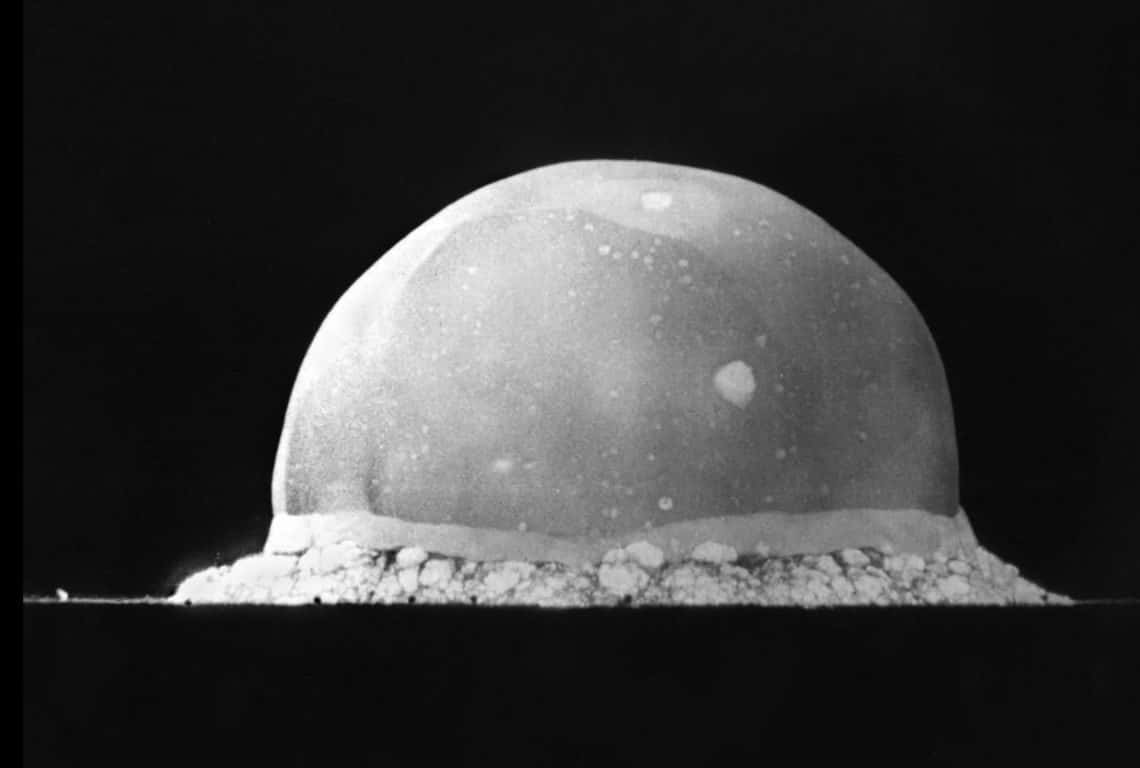
Image Credit: Author Berlyn Brixner via Wikimedia Commons Trinity Test Fireball / Hiroshima Peace Memorial Park Self-Guided Walking Tour
When Germany surrendered to the Allies in May 1945, it became clear that the atomic bomb might be used on Japan. Japan continued to refuse to surrender to the Allies and publicly rejected Potsdam Declaration.
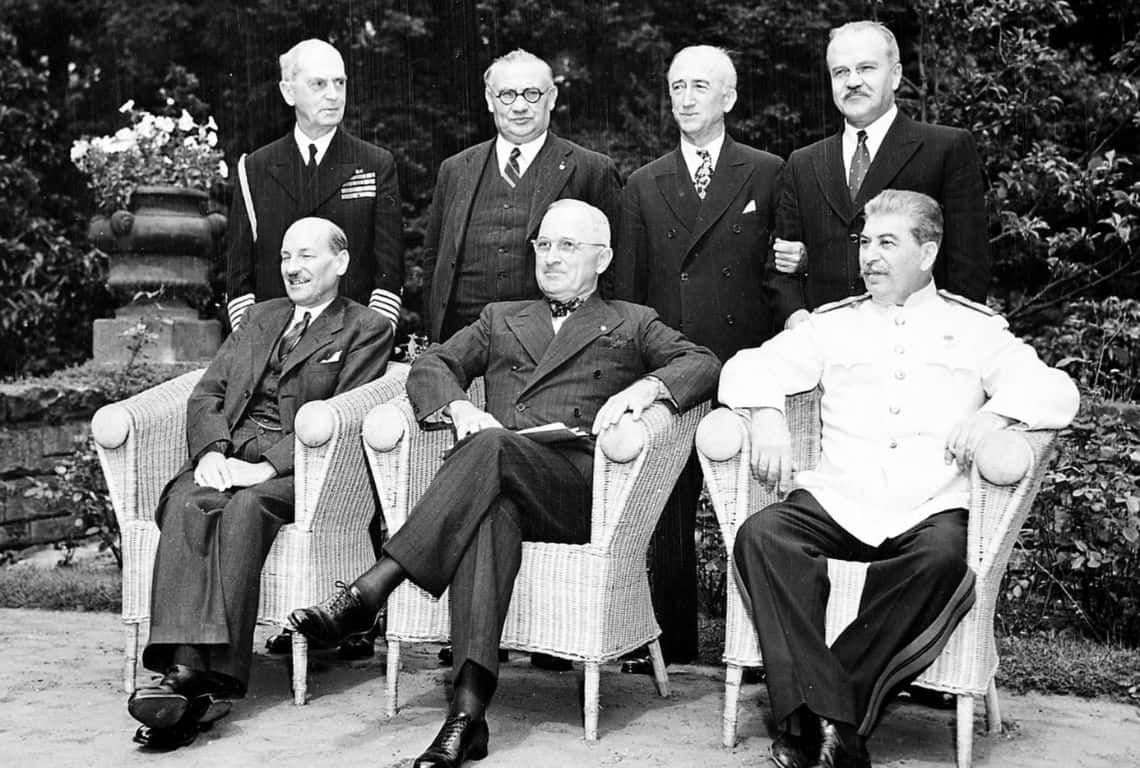
Image Credit: Presidential Collection of Harry S. Truman via Wikimedia Commons
Seated in the garden of Cecilienhof Palace in Potsdam, Germany, L to R: British Prime Minister Clement Attlee, President Harry S. Truman, and Soviet Prime Minister Josef Stalin. L to R, behind them: Adm. William Leahy, British foreign minister Ernest Bevin, Secretary of State James Byrnes, and Soviet foreign minister Vyacheslav Molotov. They are all attending the Potsdam Conference.
The general opinion was that the Japanese would fight to the bitter end.
The invasion of the islands by combat forces was calculated to be costly. An opinion that dropping one or more atomic bombs might convince the Japanese that further fighting was futile. And, since the atomic bomb was available, President Truman authorized the attack on Hiroshima.
Charles Maier, a professor of history at Harvard University, said that while it was possible for Truman to have made another decision, he said “It would have been hard to justify to the American public why he prolonged the war when this weapon was available.”
Atomic Bombing of Hiroshima
A directive approved by President Truman and issued by Secretary of War Henry Stimson and General of the Army George Marshall, ordered the Army Air Force’s 509th Composite Group to attack Hiroshima, Kokura, Niigata, or Nagasaki weather permitting.
Thus, Hiroshima was chosen because it had not been targeted during the U.S. Air Force’s conventional bombing raids on Japan. As a result, it would give a true indication of the effect of the impact of the atomic bomb. Also, Hiroshima was an important military base.
At 8:15 am on August 6th, 1945 the city of Hiroshima fell victim to the atomic bombing.
The atomic bomb with the codename Little Boy, was dropped by the United States Army Air Forces from the Boeing B-29 Bomber Superfortress Enola Gay. It was named for Enola Gay Tibbets, the mother of the pilot, Colonel Paul W. Tibbets, Jr.
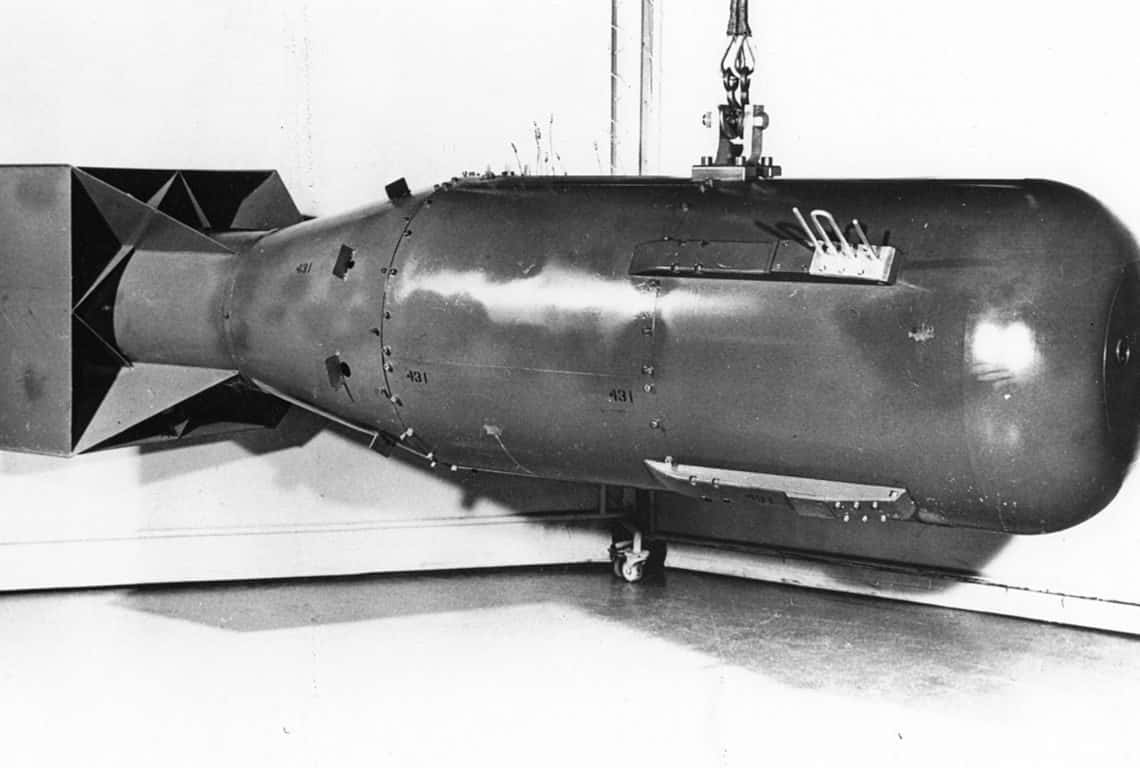
Image Credit: U.S. National Archives, RG 77-AEC. Chuck Hansen via Wikimedia Commons / Hiroshima Peace Memorial Park Self-Guided Walking Tour
The bomb was dropped by a parachute. The detonation was caused by firing one piece of uranium 235 into another and occurred at 580 m (1,900 ft) above the ground after falling for 45 seconds.
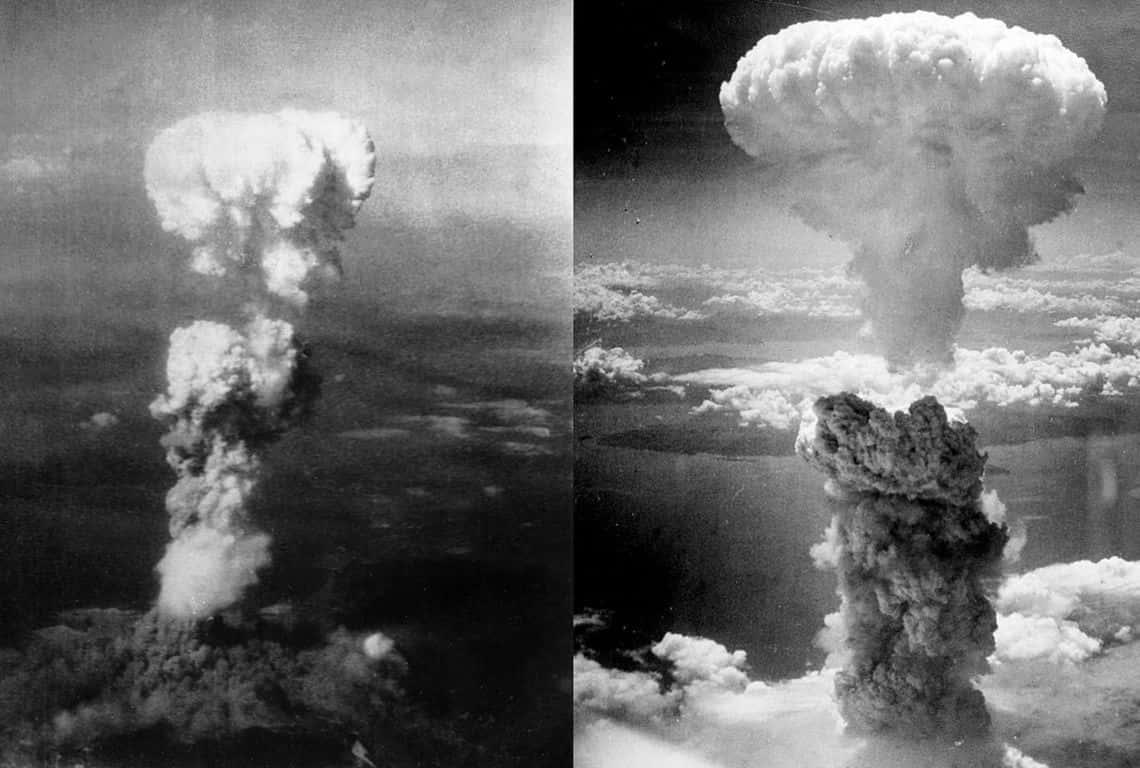
Image Credit: Author U.S. Navy public Affairs Resources Website via Wikimedia Commons. Left picture: At the time this photo was made, smoke billowed 20,000 feet above Hiroshima while smoke from the burst of the first atomic bomb had spread over 10,000 feet on the target at the base of the rising column. Six planes of the 509th Composite Group participated in this mission: one to carry the bomb (Enola Gay), one to take scientific measurements of the blast (The Great Artiste), the third to take photographs (Necessary Evil), while the others flew approximately an hour ahead to act as weather scouts (08/06/1945). Bad weather would disqualify a target as the scientists insisted on a visual delivery. The primary target was Hiroshima, the secondary was Kokura, and the tertiary was Nagasaki. Right picture: Atomic bombing of Nagasaki on August 9, 1945, taken by Charles Levy. / Hiroshima Peace Memorial Park Self-Guided Walking Tour
Hiroshima Bombing Aftermath
The intended target for the bombing was the Aioibashi bridge, a distinctive t-shaped structure that was easily recognizable from the air – just to the north of where Hiroshima Peace Memorial Park stands now.
The damage came from three main effects: blast, fire, and radiation. The blast was the result of x-ray-heated air, which sent a shock wave in all directions. Next, the fireball of the blinding light and heat created fires that merged into a firestorm.
Lastly, the radiation: soon after the explosion, a giant mushroom cloud rose upward carrying dust, dirt, ash, and other debris contaminated with radioactive fission products high into the air. It mixed with the water vapor in the air and then fell back to earth in what came to be called “black rain.”
The entire city was virtually obliterated.
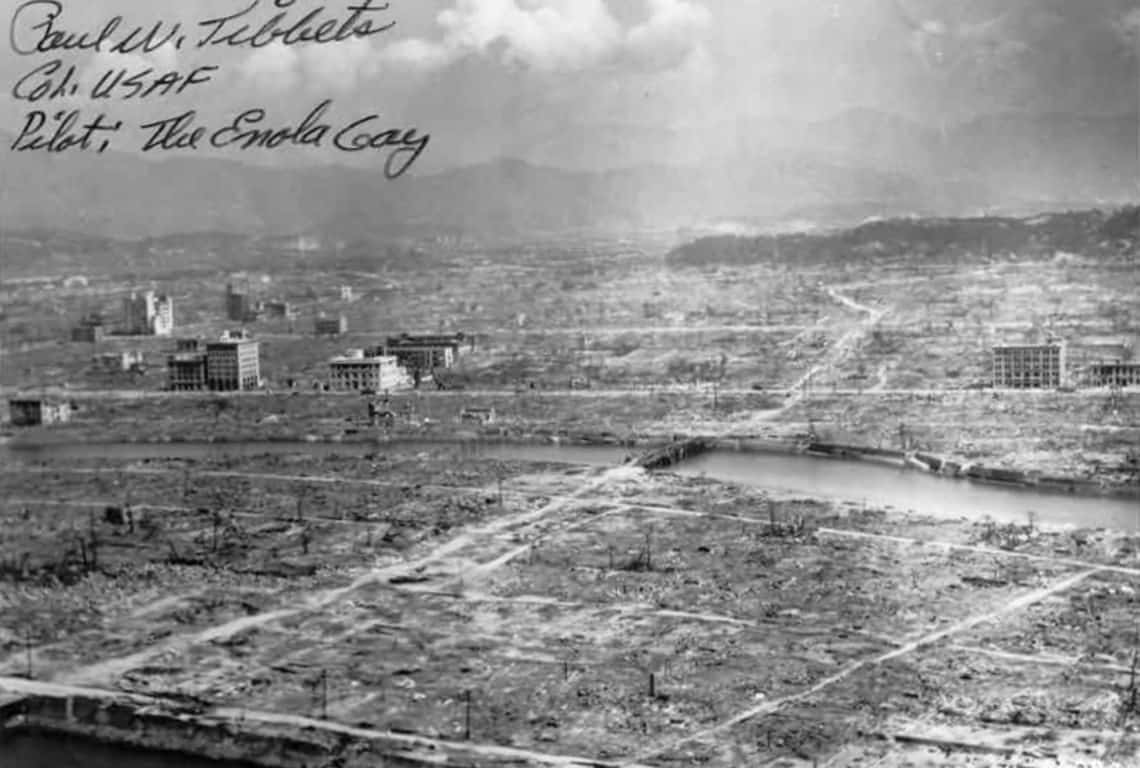
Image Credit: U.S. Navy public Affairs Resources Website via Wikimedia Commons / Hiroshima Peace Memorial Park Self-Guided Walking Tour
It is estimated that over 70,000 people were killed instantly and more than 70,000 suffered fatal injuries. Many more who managed to survive sustained permanent physical and psychological damage. Many still endure the effects today.
Nagasaki Bombing
On the morning of August 9th, 1945, the Americans dropped a second, bigger atomic bomb. The original target was Kokura, however, Kokura was shielded by thick clouds on that day, so the bomb was dropped on Nagasaki. The final death toll was calculated at least 50,000.
On August 10, 1945, Japan offered to surrender to the Allies.
Hiroshima Today
Today, Hiroshima has recovered into a bustling manufacturing hub with a population of 1.1 million people and counting.
However, the people of Hiroshima have certainly not forgotten the fact that their city was once transformed to rubble by an atomic bomb. The A-Bomb Dome, Peace Memorial Park with its monuments and memorials, and the museum will forever tell the story of the cruel tragedy of the atomic bombing.
Every year on August 6, the day the bomb was dropped, Hiroshima holds a ceremony in Peace Memorial Park.
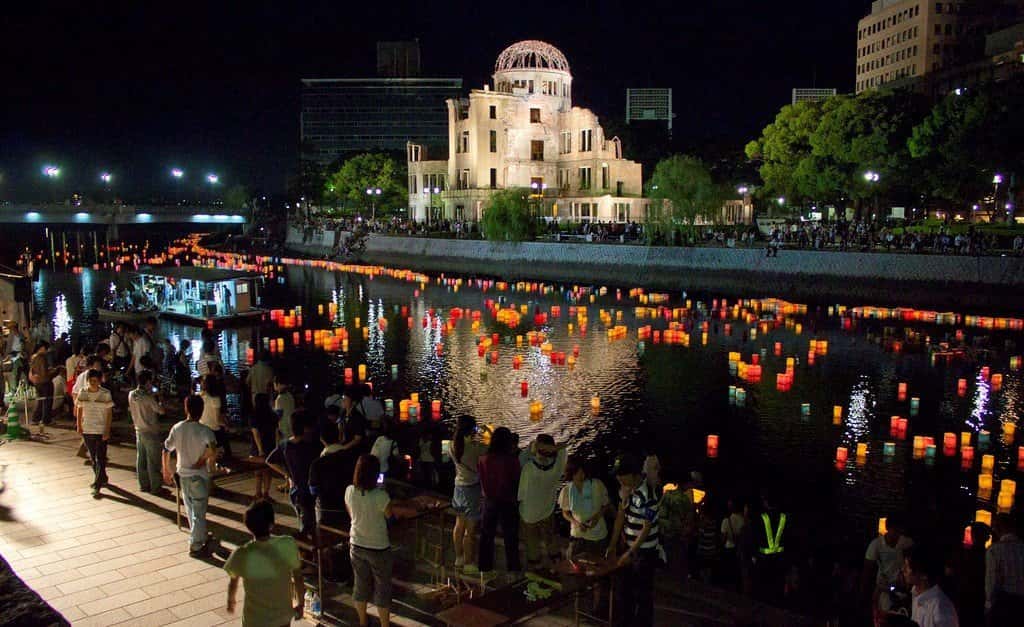
Hiroshima Peace Memorial Park Ceremony / Image Credit: terrykimura via Flickr / Hiroshima Peace Memorial Park Self-Guided Walking Tour
Map of Hiroshima Peace Memorial Park Self-Guided Walking Tour
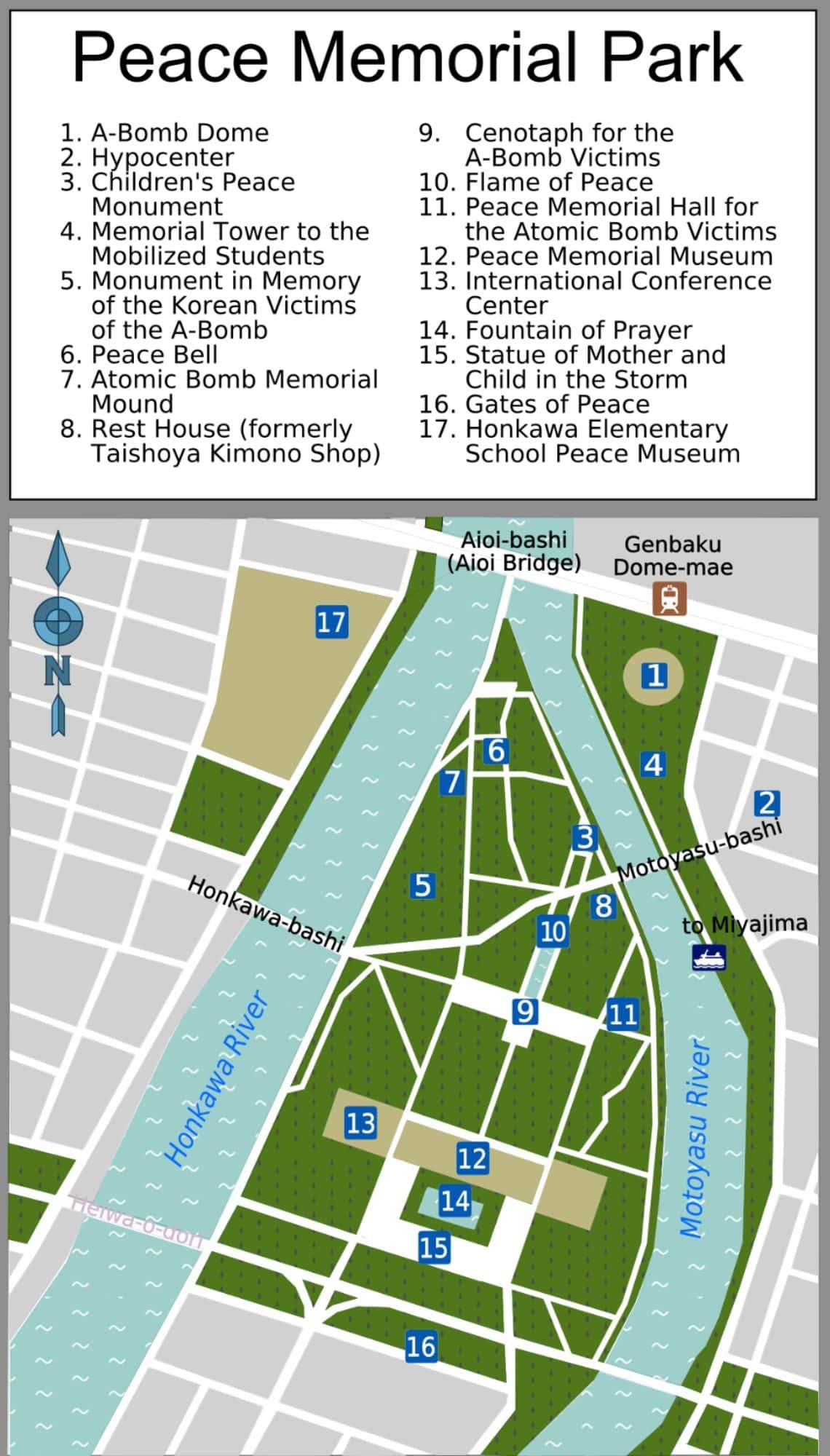
Image Credit: Marc Heiden via Wikimedia Commons / Map Hiroshima Peace Memorial Park
Hiroshima Peace Memorial Park Self-Guided Walking Tour
Hiroshima Peace Memorial Park serves as a memorial to the people who were killed in the atomic bombing of Hiroshima on August 6th, 1945. It was designed by Japanese architect Kenzo Tange and opened to the public in 1954.
The park has a total area of 122,00 square meters and houses a museum, numerous memorials, and monuments.
While visiting Hiroshima Peace Memorial Park, I found it difficult to imagine that this quiet and spacious triangle-shaped piece of land bordered by two rivers was once a busy commercial and residential downtown area.
And now, here is a step-by-step Hiroshima Peace Memorial Park self-guided walking tour:
Hiroshima Peace Memorial Park Self-Guided Walking Tour
Atomic Bomb Dome
The first stop in Hiroshima Peace Memorial Park is Hiroshima Peace Memorial (Genbaku Dome) – now commonly called the Atomic Bomb Dome or A-Bomb Dome.
The building was designed by Czech architect Jan Letzel and was completed in 1915. It served as the Hiroshima Prefectural Commercial Exhibition Hall and housed national and municipal governmental offices.
The building was located just 160 meters from the epicenter of the blast and amazingly, it was one of the few structures in the area to remain upright.
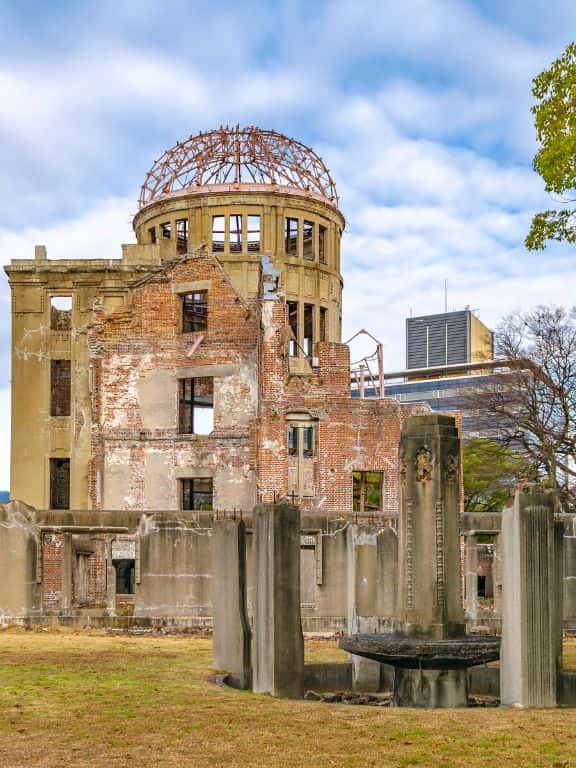
Atomic Bomb Dome / Hiroshima Peace Memorial Park Self-Guide Walking Tour
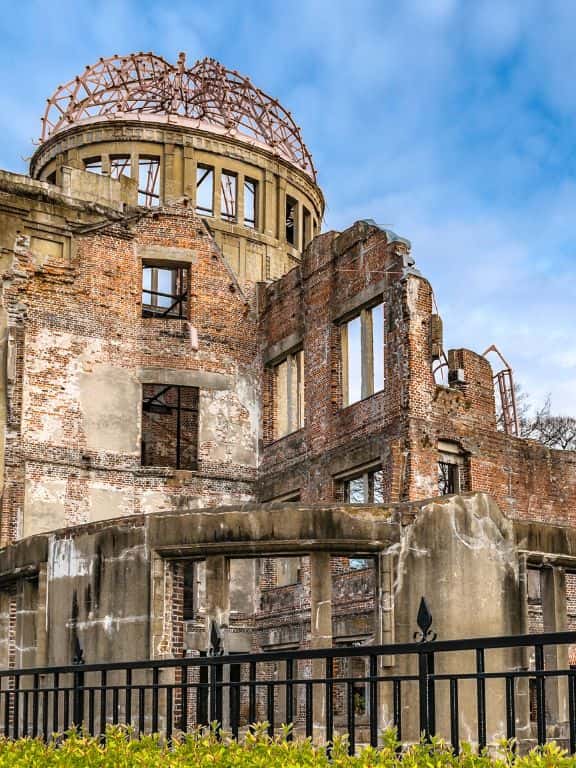
Atomic Bomb Dome / Hiroshima Peace Memorial Park Self-Guide Walking Tour
Atomic Bomb Dome was designed as a UNESCO World Heritage Site in 1996.
At night, with the lighting, the A-Bomb Dome and other memorial monuments look different than in the daytime. Darkness isolates them from the lively modern city, which makes them much more impressive to view at this hour.
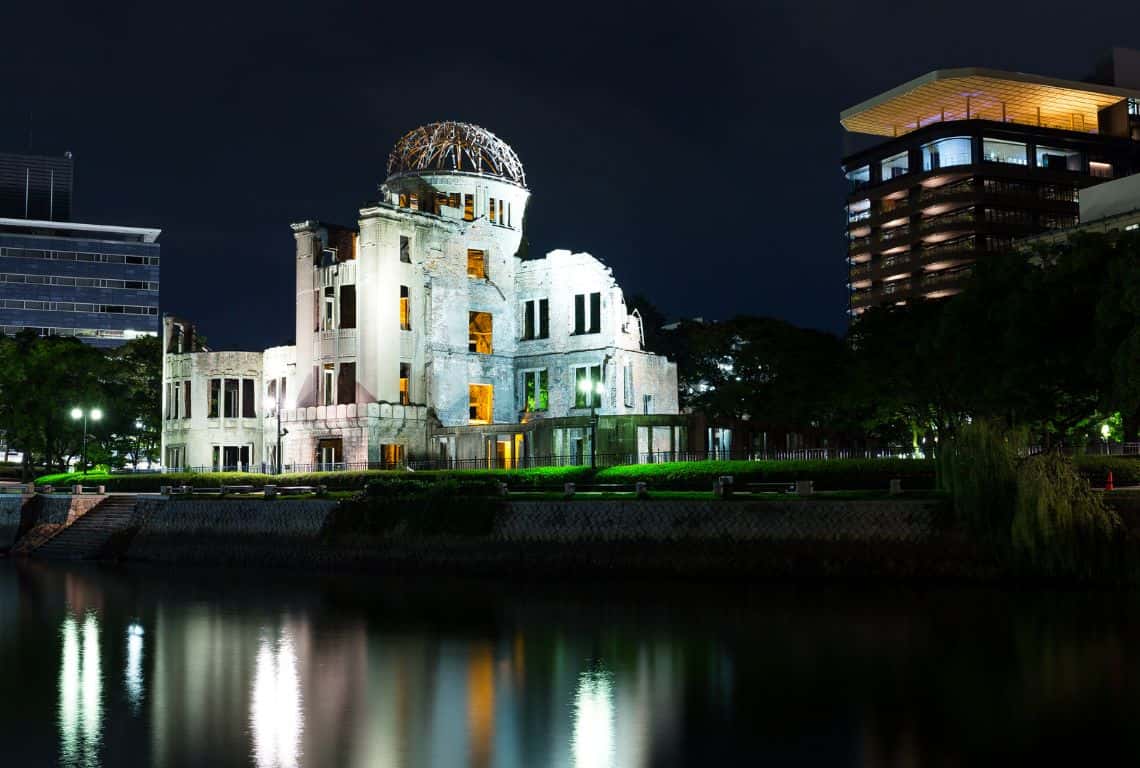
Atomic Bomb Dome at Night / Hiroshima Peace Memorial Park Self-Guided Walking Tour
Hypocenter of Hiroshima Atomic Bomb
The Hypocenter of the Hiroshima atomic bomb is marked with a memorial plaque.
The atomic bomb targeted Aioibashi Bridge, yet it exploded directly above Shima Hospital. The building was destroyed instantly, and it is estimated that 80 patients, nurses, and other individuals disappeared without a trace.
It was a sobering experience for me to stand in that spot and look up into the sky.
Children's Peace Monument
Children’s Peace Monument is a tribute to Sadako Sasaki and all the children who perished in the atomic bombing of Hiroshima.
Sadako was exposed to the A-bomb at the age of two but grew into a strong and healthy girl. Nine years later, she suddenly contracted leukemia. After an eight-month battle with the disease, she succumbed.
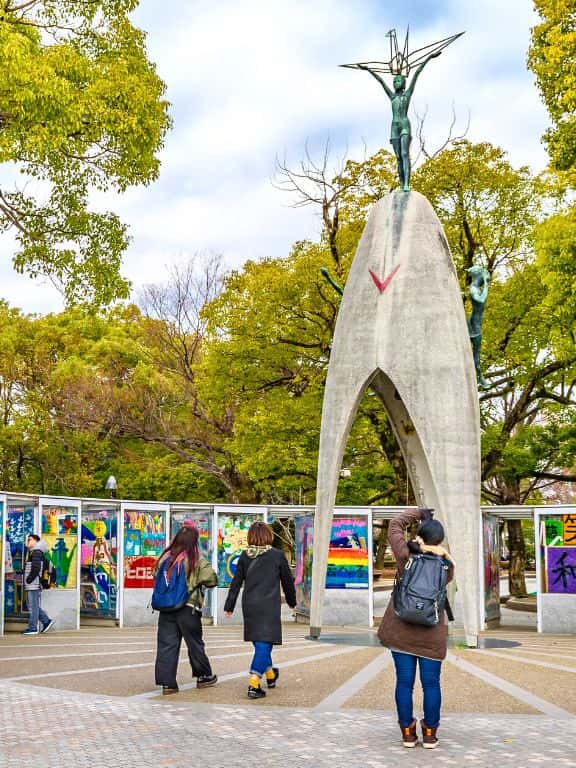
Children’s Peace Monument / Hiroshima Peace Memorial Park Self-Guide Walking Tour
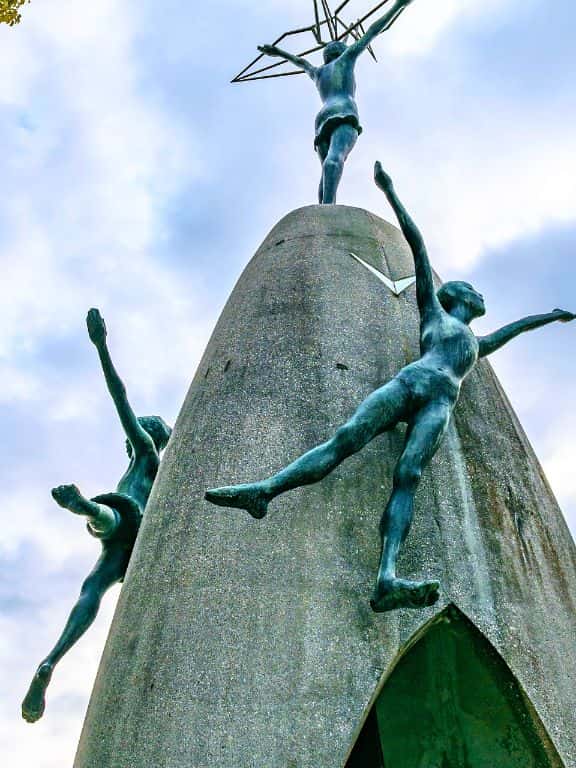
Children’s Peace Monument / Hiroshima Peace Memorial Park Self-Guide Walking Tour
Hiroshima Children’s Peace Monument is also known as the “Tower of a Thousand Cranes”. When you get to the monument, you will see brightly colored cranes everywhere.
These cranes came from the Japanese tradition of origami or paper folding. Sadako believed that if she folded 1,000 origami cranes she would recover. She continued folding them to the last moments of her life. Today, paper cranes are known as the symbol of peace.
Sadako’s death triggered a movement to build a monument for the children who perished due to the atomic bomb. Children’s Peace Monument was completed on May 5th, 1958.
The Flame of Peace Sculpture
The Flame of Peace sculpture was designed by Kenzo Tange. The base of the sculpture represents two wrists joined together, and the two wings on either side represent two palms facing upwards to the sky.
The Flame of Peace sculpture was designed both to console the souls of the thousands who died begging for water and to express the hopes for the abolition of nuclear weapons and the realization of lasting world peace.
The flame at the top was lit on August 1, 1964, and has been burning ever since in protest of nuclear weapons, and will continue to burn until there are no nuclear weapons left on earth. Source: Hiroshima Peace Tourism
The Flame of Peace Sculpture / Hiroshima Peace Memorial Park Self-Guided Walking Tour
Cenotaph for the A-Bomb Victims
Cenotaph, also known as the Memorial Monument for Hiroshima for the A-bomb Victims is located in the center of the park. It consists of a stone coffer beneath an arch. Within the coffer is a record of the names of victims of the atomic bombing.
Cenotaph is inscribed with the phrase: “Let all the souls here rest in peace for we shall not repeat the evil.”
Cenotaph for the A-Bomb Victims / Hiroshima Peace Memorial Park Self-Guided Walking Tour
Hiroshima Peace Memorial Museum
Hiroshima Peace Memorial Museum was built by the city of Hiroshima and it was opened to the public in 1950.
The museum collects materials that convey the horror of Hiroshima’s atomic bombing. It displays artifacts, photographs, and paintings that show Hiroshima before and after the bombing.
It demonstrates the present current status of the nuclear age.
The museum has been going through extensive renovation projects since 2017. It reopened its doors on April 25th, 2019 with two new permanent exhibitions, titled Hiroshima on August 6 and Victims and Survivors.
The exhibitions tell the story of the day the Allied forces dropped an atomic bomb on the city of Hiroshima at the close of WWII and its aftermath.
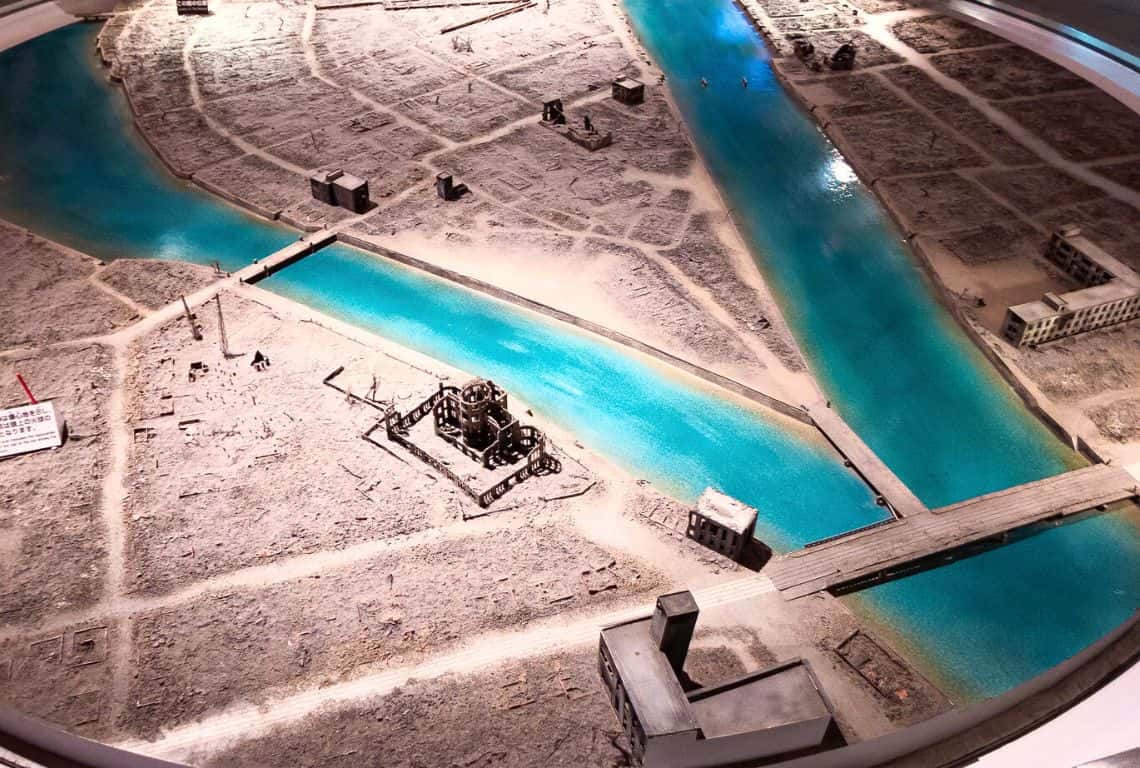
Hiroshima Peace Memorial Museum/ Hiroshima Peace Memorial Park Self-Guided Walking Tour
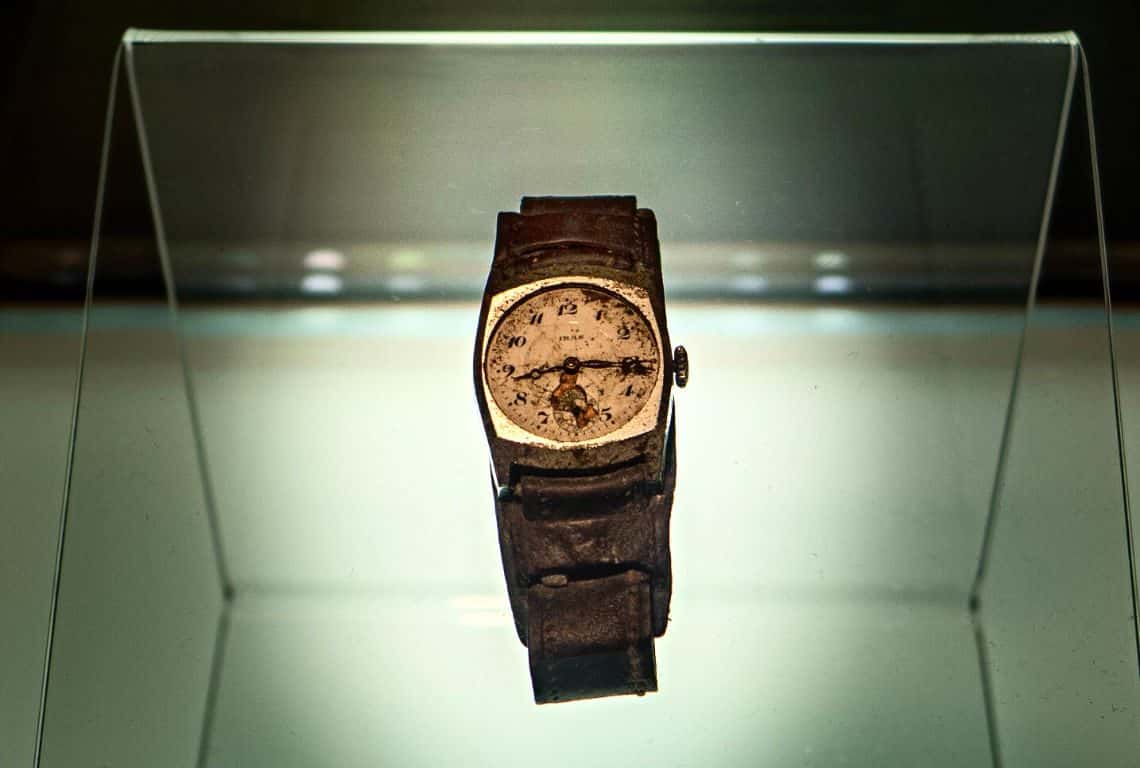
Hiroshima Peace Memorial Museum / Hiroshima Peace Memorial Park Self-Guided Walking Tour
- Third Floor of the Museum
Introductory Exhibit – see the photographs, panels, videos, and panorama models of Hiroshima. See the daily lives of people in Hiroshima and learn how they were lost in the atomic bombing.
The Dangers of Nuclear Weapons – get informed about the development, testing, and use of atomic bombs; learn about the damage caused by shock waves, firestorms, and radiation.
- Second Floor of the Museum
Hiroshima History – learn about Hiroshima during the war, recovery efforts after the war, and the struggles to eliminate nuclear weapons.
- First Floor
Outline of Atomic Bomb Damage – Hiroshima Peace Memorial Museum Special Exhibition Room – this is the most poignant part of the museum. Here, you will see the victims’ belongings donated to the museum by the victims of the terrible attack or their family members.
Here, you will read the accounts of survivors which show the misery of the bomb attack.
The photographs of the effects of the bombing and the results of the subsequent radiation are heart-wrenching.
For opening hours and admission fees click here.
Allow at least 2 hours for your visit. Enter the museum from the first floor and take the escalator to the third floor. Start the tour from the third floor and work your way down to the first floor.
Hiroshima National Peace Memorial Hall for the Atomic Bomb Victims
This memorial is a very special place. It was opened by the Japanese government in 2002 and is a place to mourn the victims of the atomic bombing.
It contains thousands of written and video testimonials by survivors of the bombings and photographs of those who were killed.
Aogiri Trees Exposed to the Bombing
These aogiri (Chinese parasol) trees were originally growing 1.3 kilometers from the epicenter of the explosion and took the full force of the heat and blast.
Interestingly enough, although apparently dead, the next spring after the bombing, they started to bud again, giving hope to the people of the city.
The trees were transplanted to their current location in the Hiroshima Peace Memorial Park by the east building of the Peace Memorial Museum in 1973.
Intrepid Scout's Final Thoughts About Hiroshima Peace Memorial Park
I hope the visit to Hiroshima Peace Memorial Park leaves you as struck as I was by the brutal physical, mental and emotional agony felt by so many.
War is hell. It does not matter who started it or who ended it. Or, if the acts were justified or not. War is hell. War affects everyone.
The park’s paths are filled with memorials, monuments, and tributes. One after the next, all of them are reminders of the inhumanity of war.
But, while visiting Hiroshima Peace Memorial Park, I felt something else as well: I felt that there is hope for forgiveness and above all – hope for peace.
Now, It Is Your Turn, I Would Like to Hear Back from You!
Are you planning your trip to Hiroshima? What is on your list of things to do in Hiroshima?
Please let me know! Drop me a quick comment right below!
Click on any of the images below to get inspired and to help you with the planning process for your trip to Hiroshima!
More Information About Japan:
14 Amazing Things to Do in Arashiyama (Map+Useful Tips)
What to See at Nijo Castle in Kyoto (10 Top Things to Know)
Stunning Golden Pavilion in Kyoto (How to Visit and What to See)
Amazing Fushimi Inari Taisha in Kyoto (8 Things to Know Before You Visit)
First Visit to Kyoto – How to Visit and What to See (11 Things You Can’t Miss)
Perfect Day Trip to Miyajima from Kyoto, Osaka, or Hiroshima
2 Days in Kyoto: The Perfect Kyoto Itinerary
How to Visit Hiroshima and Miyajima in One Day (3 Easy Steps)
Did You Find This Post Useful?
Why Not Save One Day in Hiroshima to Your Pinterest Board!
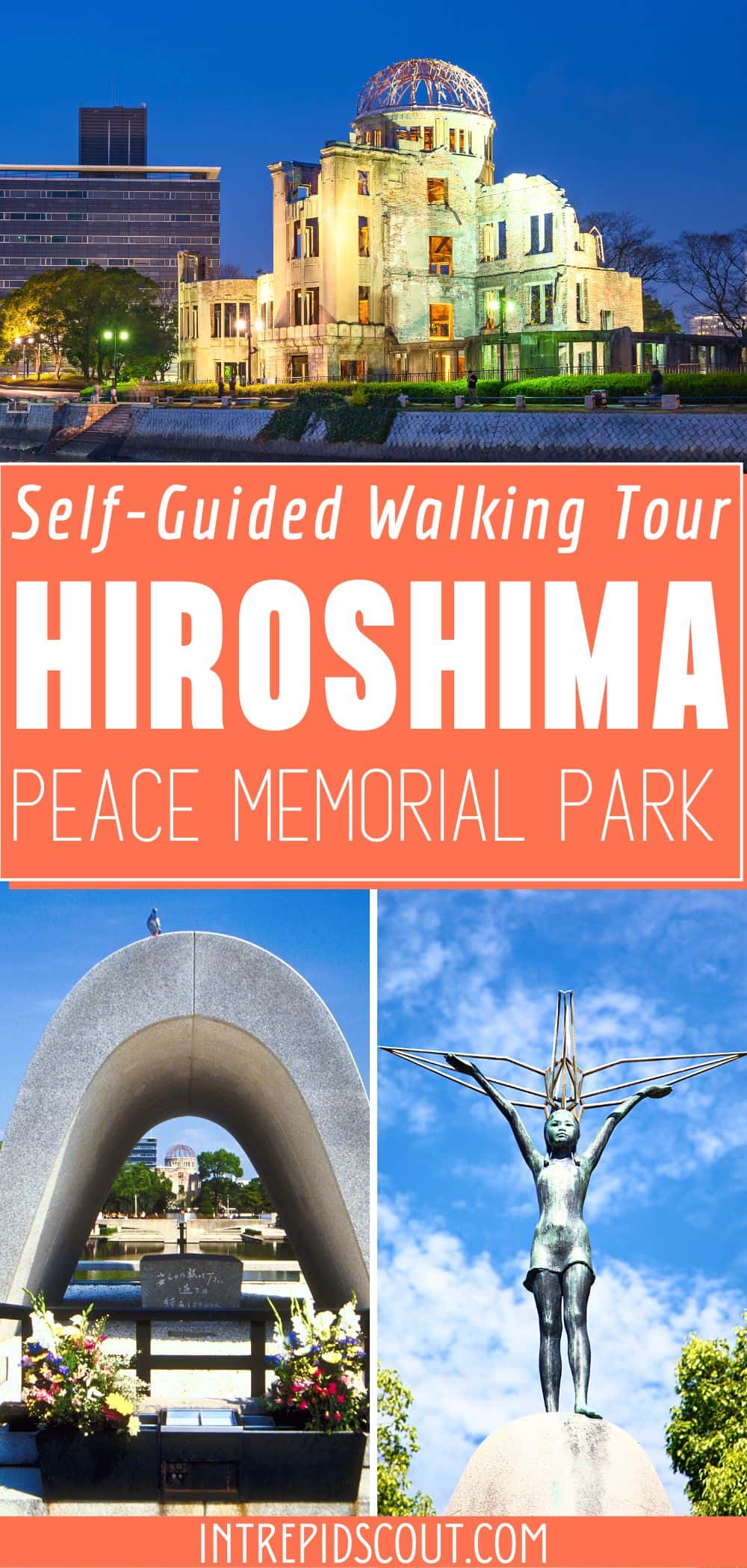
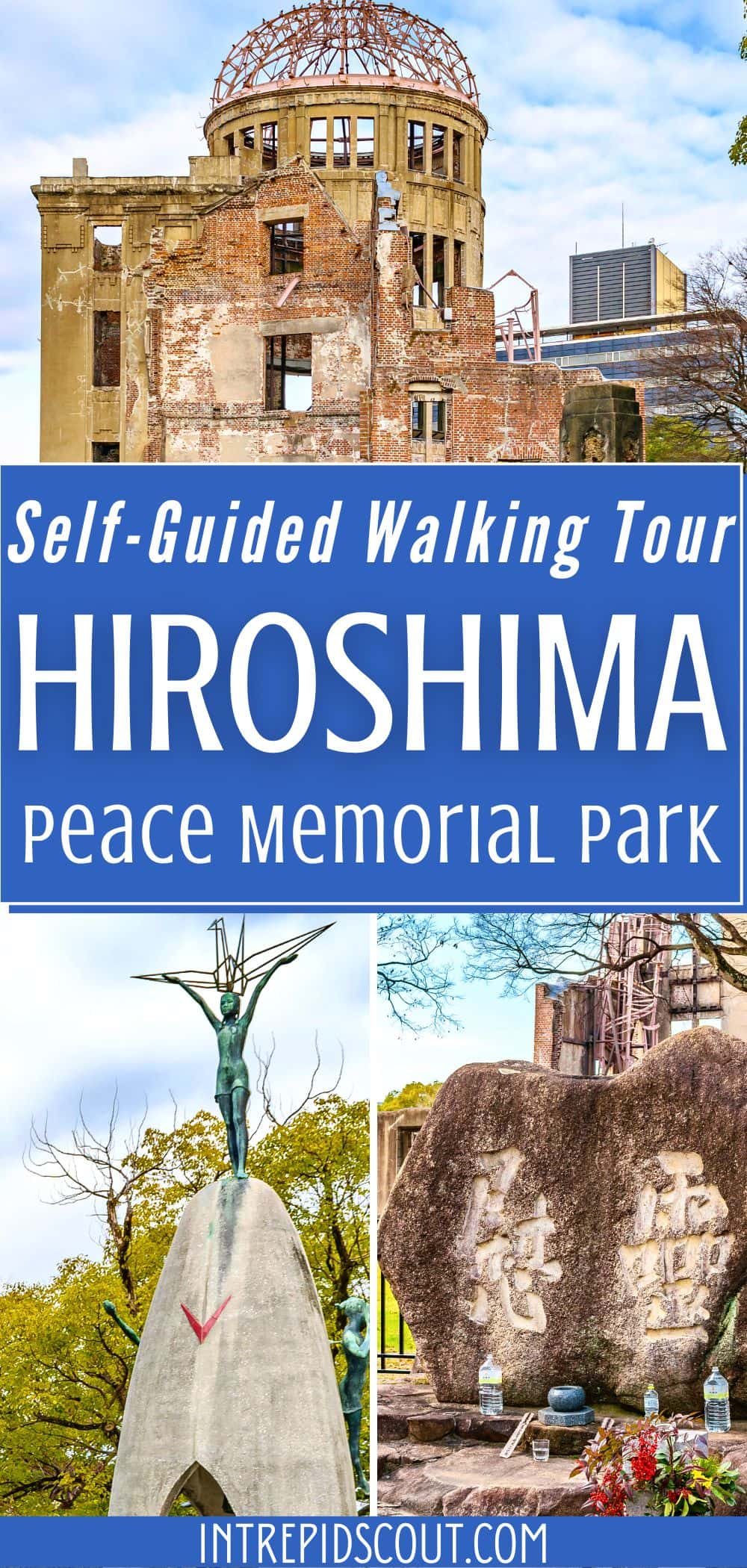
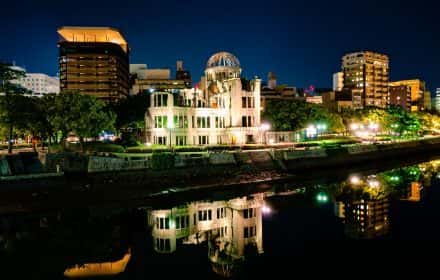
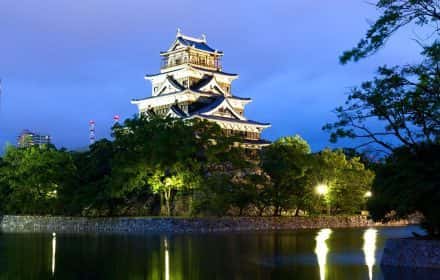
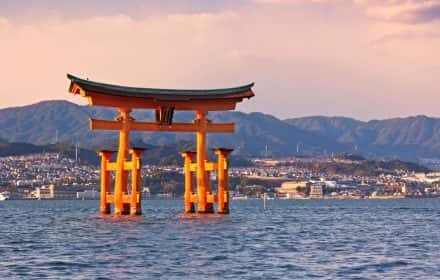
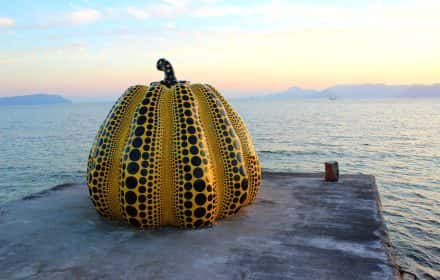
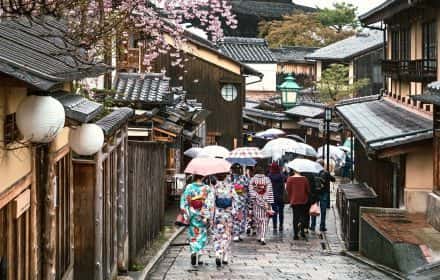
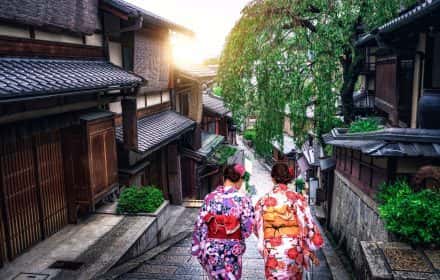
Comments:
4 thoughts on “Hiroshima Peace Memorial Park SELF-GUIDED WALKING TOUR (8 Easy Steps)”
Great photos. Thank you for the information about the museum. If I don’t have time to view the whole building, it is nice to have a guide of what I should focus on.
Great! I am glad you like it. There is so much to see and experience that you need to stay focused.
As always, thank you for your comments!
This is the first time that I’ve heard of the Hiroshima Memorial Park, but I’ve always assume that there was one. I love that you started with so much history (I’m a history teacher) and then went on to share what Hiroshima is like today. I would love to visit this memorial park one day.
Thank you, Leah. I am a history fanatic. I love it. I study all the historical events before I travel to any destination.